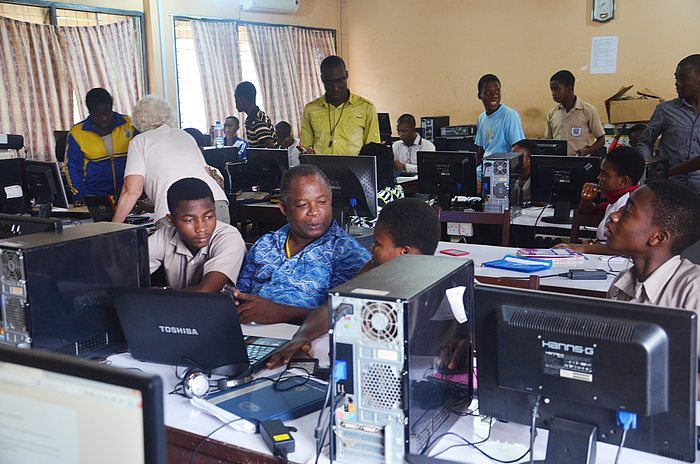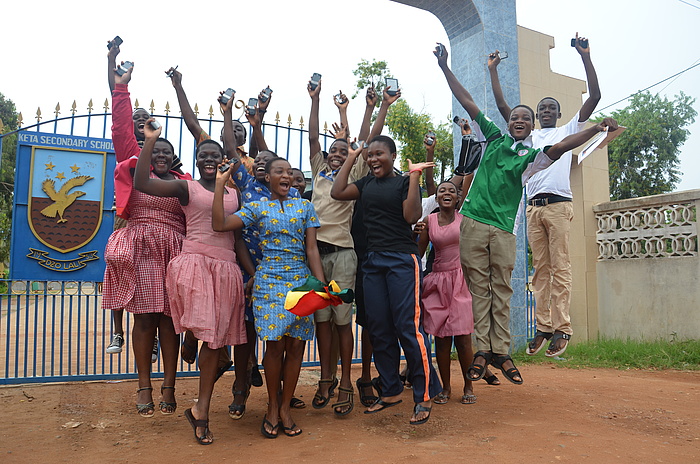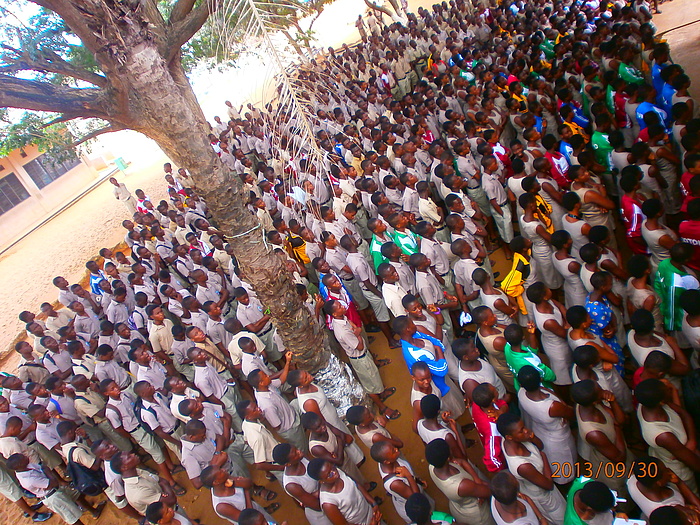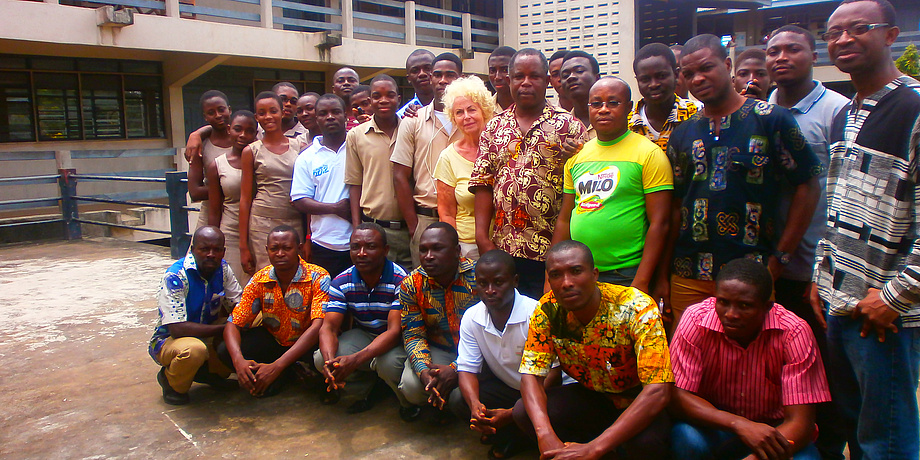A challenge during retirement
Retirement after 43 years in Austrian teacher training and continuing education? That can’t be everything, surely! My life has always been full of exciting tasks. In the late 1980s, when I was 40 and working full time, I enrolled in a university computer science programme because I was simply interested in what a computer was and what it could do. My colleagues at university were practically all male and younger than my son. In those days, computer science was virtually unheard of in teacher training. It took until the turn of the millennium before I was in a position to implement a few so-called information and communication technology (ICT) projects at primary school level together with some creative students and teachers from the College for Teacher Education (Pädagogische Akademie).When it was time for me to retire and the network administrator at the University College of Teacher Education asked me if I was willing to help a school in Kano, Nigeria to prepare the teaching staff for the use of computers and internet for teaching pupils, I was thrilled. Something new at last and on my own private initiative! The Austrian Computer Society (OCG) wrote about it, and an Austrian lady living in Cape Town learnt about it and invited me to teach a course in South Africa to the inhabitants of a township with a view to improving their career prospects. Based on the reports published by the OCG and my own publications, the Austrian NGO ICT for Development suggested that these activities be widened. This is how the project in Ghana came about, and I would now like to describe it a little bit.
Double start
It was the declared aim of the initiative to widen the educational possibilities for both pupils and teachers in Ghana by launching the use of digital media. Two months before my flight to Ghana, I received a phone call from professor Holzinger at the “Institute of Interactive Systems and Data Science” of TU Graz. He said that I was finally going to have the time to do my doctoral studies – something I hadn’t had time to follow up when I was teaching at the University College of Teacher Education. So in 2012, on one and the same day, I booked my flight to Ghana and registered once more at the university.It was the declared aim of the initiative to widen the educational possibilities for both pupils and teachers in Ghana by launching the use of digital media.
Situation in Ghana
Ghana has been a safe country ever since it gained its independence in 1957. It has a population of about 28 million and ranks second among all African states in the Global Human Capital Index 2017. Almost 40 per cent of the population are younger than 14 years of age. In terms of demographics, the Christian religions prevail, with relations between the religious denominations being very good. The official language is English, and this is a major advantage for all educational projects. It needs to be said, though, that there are some 40 local languages, and that only about 70 per cent of all Ghanaians understand English. While there are hardly any landlines, the mobile telephone network has witnessed a dramatic rise recently. Together with smartphones becoming cheaper and cheaper, this offers excellent opportunities to make use of the broad range of services in the World Wide Web. Now, an Education Strategy Plan for the period 2003 till 2015 included ICT in the curriculum of the secondary level, however, with great shortcomings in implementation.
Implementing a vision
The concept for the project “Enhancing learning with use of digital devices” in Ghana was developed by me in a one-year preparation phase together with the teacher Gameli Adhazo and Austrian friends of ICT4D.at. The project was implemented at Keta Senior High Technical School (KETASCO) in Keta on the south coast of Ghana over a period of time of three years (without any external funding).Many of the approx. 3,000 KETASCO students lived in a students home with huge dormitories and toilets and shower rooms in another building. I myself lived at the campus with a family of teachers who made me feel very welcome. As for ICT, we had only one computer lab with 15 computers, which we tried to make as much use of as possible for our project.
In the course of three workshops held between 2012 and 2014, I started working with teachers and soon after with mixed student and teacher teams. I was supported in the project by TU Graz professor Martin Ebner and his staff, who were always of great help with the input they gave, for example via the “ABC Platform” of the University or with teaching content that was able to be offered on the internet in various formats. Because of the poor internet connection of the school, the online platform was changed over to the locally installed software “Calibre” in the third workshop.
I was supported in the project by TU Graz professor Martin Ebner and his staff, who were always of great help with the input they gave, for example via the “ABC Platform” of the University or with teaching content that was able to be offered on the internet in various formats.
By the end of the project, a lot had changed for everybody: the teachers had learnt how digital teaching content can make teaching much more interesting while the students had gathered experience that would accompany them on their way to self-guided learning. All these experiences will enable them to make the best use of online educational offers, such as MOOCs and other Open Educational Resources. After all, regular access to tertiary education is hardly an option for many of them. A Mobile Learning Society (MLS) founded by the girls at the end of the third workshop to share their experience with the students and teachers of other schools, and to communicate and deepen them secured the success of the project for the future.
Criteria of success of the project
While working at KETASCO, the participants in the project realised what was essential for the success of such projects under similar conditions; these are:- A high motivation: the teachers took part in the project out of their own accord. The pupils were incorporated from the second workshop onward because they showed great interest in the activities.
- Making use of the resources available at the school: nothing is gained if extra equipment is made available just for the course of a project which is then no longer available when the project has finished.
- A high degree of flexibility during the classes: during the frequent power cuts mobile phones can still be used because they have a much better battery running time than PCs. Mobiles can then still be used to make audio and audio-visual contributions, or to deal with learning modules. Most of the students owned such gadgets themselves and can handle them extremely well while mostly there was just one PC lab for hundreds of users. Of course, for developing digital learning units, the PCs in the lab were invaluable with their keyboards and available software.
- Learning units for mobile terminals: when establishing the learning units, the loading capacities of mobile devices for pictures and videos and limited space on the much smaller mobile phone screens had to be taken into consideration.
Three workshops between 2012 and 2014
First three-week workshop: the topic was how to use computers in teaching. In September 2012, 15 teachers with various levels of computer skills attended voluntarily in their leisure time. The high motivation of the participants by far outdid all the many unpleasant situations, such as very frequent power cuts and poorly maintained computers, many of which were infected with viruses. Some used their own laptops which they had received free of charge from the Federal Ministry of Education on the basis of a campaign. Although not used to it, the participants were eager to indulge in this open form of shared learning process.Second workshop: in September 2013 it soon became obvious that the students at the campus were extremely interested in what was going on in the computer lab. Despite a ban to do so, they started to use their mobile phones at the campus to record discussions or do some research in the internet. After some hesitation at the beginning, the teachers were soon ready to have as many senior students as possible sharing in the workshop. Jointly, they worked on elaborating learning modules on the various specialties, which were converted to pdf and e-pub formats and stored in the Cloud and on the terminals in the computer lab before being tested with the help of mobile phones and eReaders. After some feedback loops involving other teams, external teaching staff assessed the modules. Additionally, mixed teams worked on the guidelines for how to use mobile gadgets, such as mobile phones, eReaders, and laptops.
The high motivation of the participants by far outdid all the many unpleasant situations, such as very frequent power cuts and poorly maintained computers, many of which were infected with viruses.
Third workshop in June 2014: here, the focus was on the new learning and working methods in the areas of science, technology, engineering, mathematics (STEM). Teams composed of teachers and students carried out interviews with their co-students and teachers at the campus, recorded them using mobile phones, and made transcriptions of the interviews. When there were power cuts, they made good use of the time by collecting materials to supplement existing learning modules which they would research later using the internet. The teacher teams established structures for brief learning modules consisting of the relevant objective to be reached, the individual working steps, and the overall tasks. In the third workshop, the Ketascomobile blog was born to communicate the participants' experiences via the internet.
Follow-up after the project
After the official end of the project in 2014, the students of KETASCO continued to work with their teachers. We can see from photos and videos, though, that the young people carried out their activities mainly out of their own accord. Let me give a few examples here:- Students documented the <link http: grimus.or.at ketascomobile _blank int-link-external external link in new>salt extraction in a nearby lagoon using a drone.
- They built solar panels.
- They programmed robots.
- They came second in a competition organised by the eLearn-Africa Congress in 2015 and documented this on the internet.
- KETASCO student teams organised workshops in other schools.
- Students developed mobile apps, and one student even made it onto Ghanaian TV doing that.
- Noah, a participant in the 2013 and 2014 workshops is now a third-year student in IT at Kumasi University, and is the main initiator of various activities, such as ICT workshops for students and teachers. In the autumn of 2017, he organised <link https: djangogirls.org ho _blank int-link-external external link in new>programing workshops in Ho and <link https: djangogirls.org koforidua _blank int-link-external external link in new>in Koforidua together with the Django Girls. Unfortunately, he was denied entry to the US by the US embassy in September 2017 where he wanted to take part in a workshop in California to which he had been invited by Google for his outstanding effort and achievements.
After the official end of the project in 2014, the students of KETASCO continued to work with their teachers. We can see from photos and videos, though, that the young people carried out their activities mainly out of their own accord.
Changes in teaching structure
Although in Ghana and most other African countries there are various traditions, cultures and hierarchies, it was shown that new didactic paths and learnings were able to be explored in a joint effort. Computer-based methods are indispensable in the 21st century. This holds particularly true for the universities and tertiary educational institutes in Africa, access to which so many are excluded. Therefore, it is of particular importance that the young people there have access early on in their lives to independent and self-guided learning.For me, it was so impressive to see how easily changes to the learning and teaching situation can be initiated – even without any additional help and separate from the mostly very slow educational institutions. This was in great contrast to what I was able to do for the educational institutions back in Austria, but for me all the more enriching.
Margarete Grimus worked in teacher training and continuing education, among others in the area of computer science, at the University College of Teacher Education. In 1994 she completed her studies in data technology and computer science in Vienna. From 2000 till 2009, additionally to working as a teacher at the University College of Teacher Education, she was one of the tutors in the Master of Education course at the University of Derby, GB. She has been active throughout Europe in drawing up curricula and lecturing. In 2010, she started to research strategies and methods for mobile learning to help raise the educational level in developing countries. In 2012, she started to work on her doctoral thesis in the field of computer science at TU Graz. She graduated in October 2017.
